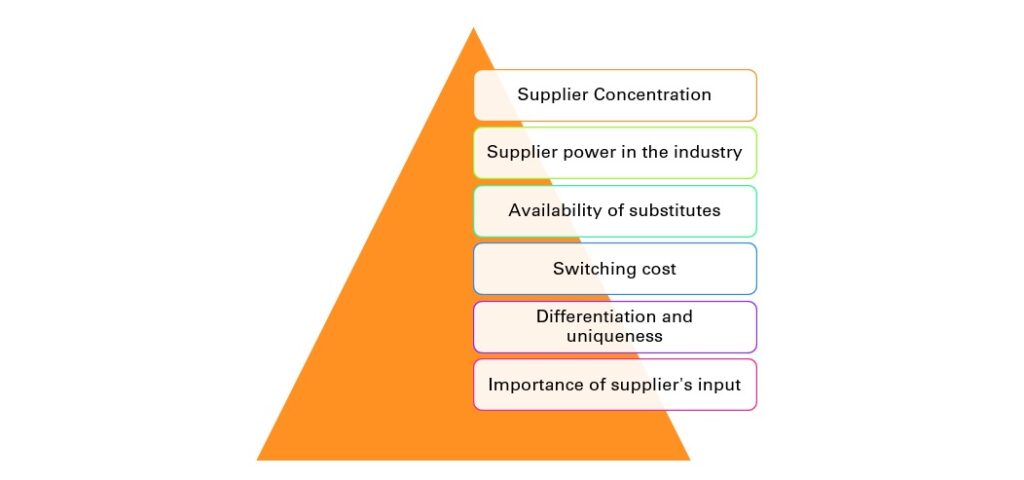In the realm of strategic analysis, Porter’s Five Forces framework has long been revered as a powerful tool for evaluating industry dynamics. Among its five forces, the bargaining power of suppliers holds a pivotal position in shaping market competitiveness. In this blog post, we delve deep into the intricacies of the bargaining power of suppliers, exploring its significance, key determinants, and strategic implications for businesses. By comprehending the dynamics of supplier power, companies can effectively navigate their supplier relationships and gain a competitive edge in the market.
Understanding the Bargaining Power of Suppliers: The bargaining power of suppliers refers to the ability of suppliers to influence the terms, conditions, and pricing of the goods or services they provide. It represents the supplier’s leverage over buyers, which can significantly impact the profitability and competitive position of businesses. Analyzing supplier power requires a thorough assessment of several key factors.
Key Determinants of Supplier Power: To better understand the bargaining power of suppliers, we must consider the following key determinants:

- Supplier Concentration: When a few suppliers dominate the market, they possess greater bargaining power. Their ability to dictate prices, terms, and conditions increases as buyers have limited alternatives. This scenario is particularly common in industries where specialized inputs or resources are required.
- Supplier Power in the Industry: The relative power of suppliers can vary across different industries. Some industries may have suppliers with strong bargaining power due to factors such as limited supplier availability, high entry barriers for new suppliers, or industry-specific regulations. It is essential to consider the industry-specific dynamics when assessing the bargaining power of suppliers.
- Availability of Substitutes: The presence of readily available substitute products or services weakens the bargaining power of suppliers. Buyers can easily switch to alternative suppliers, thereby reducing the supplier’s influence over pricing and negotiations.
- Switching Costs: High switching costs amplify supplier power. If the cost of switching suppliers is substantial, either financially or operationally, buyers are more likely to succumb to the supplier’s demands. Suppliers can exploit this situation by raising prices or imposing unfavorable conditions.
- Differentiation and Uniqueness: Suppliers with unique or differentiated offerings possess a stronger bargaining position. If a supplier provides specialized input or possesses exclusive capabilities, they hold a competitive advantage over buyers. This uniqueness allows them to demand higher prices and impose stricter terms.
- Importance of the Supplier’s Input: When a supplier’s input is critical to the buyer’s operations, their bargaining power increases. If the supplier’s input is scarce, difficult to replicate, or represents a significant proportion of the buyer’s costs, they can exert substantial control over pricing and conditions.
Strategic Implications for Businesses: Understanding and effectively managing the bargaining power of suppliers can yield numerous advantages for businesses. Here are some strategic implications to consider:
- Supplier Relationship Management: Nurturing strong relationships with suppliers is crucial for negotiating favorable terms and conditions. By building trust, open communication, and collaborative partnerships, businesses can create a win-win situation, ensuring a steady supply of high-quality inputs at reasonable prices.
- Diversification of Suppliers: Over-reliance on a single supplier exposes businesses to significant risks. Diversifying the supplier base helps mitigate vulnerabilities and reduce dependence on a particular source. It also provides access to alternative options during price negotiations and minimizes supply chain disruptions.
- Strategic Sourcing: Conducting a thorough analysis of potential suppliers before engaging in partnerships is essential. Evaluating the supplier’s market power, reliability, quality standards, and pricing structures helps businesses select the most advantageous suppliers and establish mutually beneficial relationships.
- Supplier Collaboration and Innovation: Engaging suppliers in collaborative initiatives, such as joint research and development or process improvement projects, can enhance both the buyer’s and supplier’s capabilities. This collaboration fosters innovation, reduces costs, and strengthens the overall supplier relationship.
- Vertical Integration: In certain cases, vertical integration by acquiring or controlling suppliers can reduce supplier power. This strategy provides businesses with greater control over critical input and reduces dependence on external suppliers. However, vertical integration requires careful analysis and consideration of costs and benefits.
Conclusion: The bargaining power of suppliers plays a pivotal role in shaping industry dynamics and competitiveness. By understanding the determinants of supplier power and adopting appropriate strategies, businesses can effectively manage their supplier relationships, negotiate favorable terms, and enhance their competitive position in the market. Vigilant supplier analysis, strategic sourcing decisions, and collaborative partnerships enable businesses to navigate the ever-evolving supplier landscape, ensuring long-term success and sustainability in the face of changing market dynamics.